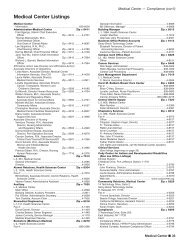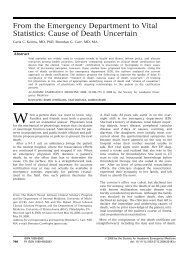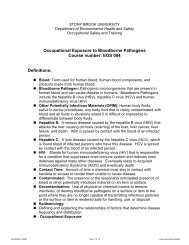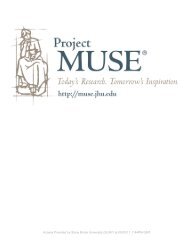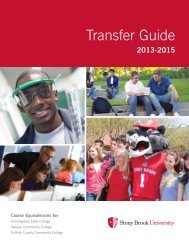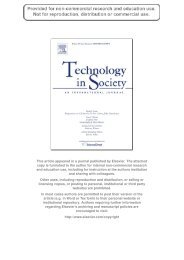Technological & Ethical Issues in Laboratory-Assisted Reproduction
Technological & Ethical Issues in Laboratory-Assisted Reproduction
Technological & Ethical Issues in Laboratory-Assisted Reproduction
You also want an ePaper? Increase the reach of your titles
YUMPU automatically turns print PDFs into web optimized ePapers that Google loves.
1<br />
<strong>Technological</strong> & <strong>Ethical</strong> <strong>Issues</strong> In <strong>Laboratory</strong>-<strong>Assisted</strong> <strong>Reproduction</strong><br />
A Short History to Accompany the Lecture<br />
Richard Bronson, M.D.<br />
Professor of Obstetrics & Gynecology and Pathology<br />
The treatment of <strong>in</strong>fertility through laboratory-assisted techniques has made great strides<br />
dur<strong>in</strong>g the last two decades. Three approaches have been taken to <strong>in</strong>crease the likelihood of<br />
fertilization.<br />
These <strong>in</strong>clude superovulation with gonadotrop<strong>in</strong>s comb<strong>in</strong>ed with <strong>in</strong>trauter<strong>in</strong>e<br />
<strong>in</strong>sem<strong>in</strong>ation, Gamete IntraFallopian Transfer (GIFT), and <strong>in</strong> vitro fertilization (IVF) and<br />
embyro transfer.<br />
The development of the assisted reproductive technologies has not been<br />
without controversy. I will review the historical development of these techniques, ethical issues<br />
created by their development, and the technique themselves.<br />
Intrauter<strong>in</strong>e <strong>in</strong>sem<strong>in</strong>ation (IUI), <strong>in</strong> comb<strong>in</strong>ation with the stimulus of follicular maturation<br />
through the use of exogenous gonadotrop<strong>in</strong>s, <strong>in</strong>creases the likelihood that high quality sperm and<br />
eggs will meet, lead<strong>in</strong>g to fertilization. At the time of follicular maturation, ovulation is <strong>in</strong>duced<br />
with the <strong>in</strong>jection of human chorionic gonadotrop<strong>in</strong> (hCG), which b<strong>in</strong>ds to LH receptors, and<br />
spermatozoa are recovered out of sem<strong>in</strong>al fluid concentrated, and placed with<strong>in</strong> the uter<strong>in</strong>e cavity<br />
near the entrance of the Fallopian tubes. The process<strong>in</strong>g of the sperm <strong>in</strong> the Andrology Lab<br />
serves several functions. It removes sem<strong>in</strong>al plasma, which conta<strong>in</strong>s prostagland<strong>in</strong>s that may
2<br />
lead to local uter<strong>in</strong>e contractions or bronchospasm. It also removes components that play a role<br />
<strong>in</strong> prevent<strong>in</strong>g spermatozoa from undergo<strong>in</strong>g capacitation and the subsequent acrosome reaction,<br />
processes essential for fertilization. The use of ISolate-densely gradient centrifugation enhances<br />
the <strong>in</strong> vitro capacitation of sperm that would normally take place with<strong>in</strong> the cervical mucous.<br />
IUI is associated with the lowest chance of conception per cycle of the various laboratoryassisted<br />
techniques.<br />
From our own experience, conception rates have ranged from<br />
approximately 12 % to a high of 28% per treatment cycle (once a month), depend<strong>in</strong>g upon the<br />
patient’s age and the cl<strong>in</strong>ical situation. However, this approach is associated with a significant<br />
risk of high order, multiple pregnancy and concurrent preterm delivery.<br />
Both Gamete IntraFallopian Transfer (GIFT) and <strong>in</strong> vitro fertilization and embyro<br />
transfer (IVF/ET) guarantee the meet<strong>in</strong>g of gametes and allow one to regulate the number of<br />
eggs or embryos placed with<strong>in</strong> the reproductive tract. GIFT was devised by Dr. Ricardo Asch, at<br />
a time when IVF culture conditions were suboptimal and did not adequately mimic those that<br />
occur with<strong>in</strong> the Fallopian tube. His concept was to recover eggs from follicular aspirates <strong>in</strong> a<br />
manner similar to that as performed for IVF, but then place them with spermatozoa directly <strong>in</strong>to<br />
the distal ostium of the oviduct. However, this approach requires either laparoscopy or a m<strong>in</strong>ilaparotomy<br />
to ga<strong>in</strong> access to the Fallopian tubes. With the improved pregnancy rates follow<strong>in</strong>g<br />
IVF and ET <strong>in</strong> the United States, GIFT is currently be<strong>in</strong>g performed with much less frequency.<br />
The <strong>in</strong>itial concept of IVF was to bypass damaged Fallopian tubes, achiev<strong>in</strong>g fertilization<br />
with <strong>in</strong> vitro culture, then return<strong>in</strong>g the preimplantation embyro to the uterus thereafter. As is
3<br />
well known, this was first accomplished by Robert Edwards, a scientist <strong>in</strong> Cambridge, England,<br />
who collaborated with Patrick Steptoe, a gynecologic laparoscopist. Louise Browne, the first IVF<br />
pregnancy, was born <strong>in</strong> 1978 <strong>in</strong> the United K<strong>in</strong>gdom. It is not as well appreciated that neither<br />
Edwards nor Steptoe were reproductive endocr<strong>in</strong>ologists. On this basis, they attempted to<br />
achieve pregnancy utiliz<strong>in</strong>g unstimulated natural cycles and frequent serial monitor<strong>in</strong>g of ur<strong>in</strong>ary<br />
LH, to attempt to def<strong>in</strong>e the <strong>in</strong>itiation of the LH surge. Although they described the fertilization<br />
of a human egg <strong>in</strong> vitro <strong>in</strong> 1969, it took nearly 10 years of repeated attempts to achieve a birth.<br />
There was also much concern with<strong>in</strong> the scientific community as to whether their work had<br />
scientific merit and was not an attempt “to be a doctor of human desire”. This term had been<br />
phrased by Paul Ramsey, a theologian at Pr<strong>in</strong>ceton University, <strong>in</strong> 1971. Indeed, both he and<br />
Leon Kass, an ethicist at the University of Chicago now <strong>in</strong> charge of the President’s Council on<br />
Bioethics, published major articles <strong>in</strong> the Journal of American Medical Association and the New<br />
England Journal of Medic<strong>in</strong>e, respectively, question<strong>in</strong>g the ethical merits of proceed<strong>in</strong>g with<br />
IVF. Dr. Kass raised the concern that conception <strong>in</strong> vitro was an experimental procedure and<br />
that the child-to-be could not consent.<br />
Alan Trounson and Alex Lopata <strong>in</strong>itially played a major role <strong>in</strong> achiev<strong>in</strong>g the first<br />
Australian IVF pregnancy. The use of Clomiphene Citrate was <strong>in</strong>troduced <strong>in</strong> an attempt to<br />
<strong>in</strong>crease the number of eggs ovulated. In the United States, the Federal government <strong>in</strong>itially<br />
placed a ban on IVF research <strong>in</strong> 1971, until it was determ<strong>in</strong>ed that IVF was medically ethical.<br />
Although this was decided to be the case, no NIH fund<strong>in</strong>g was subsequently provided for its
4<br />
development. Indeed, dur<strong>in</strong>g this time, IVF did develop rapidly <strong>in</strong> Europe. However, it was not<br />
until Howard and Georgiana Jones, after reach<strong>in</strong>g emeritus status at Johns Hopk<strong>in</strong>s University<br />
(at this time, there was mandatory retirement age!), started a second medical career at the Eastern<br />
Virg<strong>in</strong>ia Medical Center and established of a program of <strong>in</strong> vitro fertilization <strong>in</strong> Norfolk,<br />
Virg<strong>in</strong>ia <strong>in</strong> 1979 f<strong>in</strong>anced through a private benefactor, that the first IVF birth <strong>in</strong> the United<br />
States occurred <strong>in</strong> 1981. Thereafter, through the <strong>in</strong>itial efforts of the Jones to transfer the<br />
<strong>in</strong>formation they ga<strong>in</strong>ed through a series of annual meet<strong>in</strong>gs, IVF programs developed<br />
throughout the United States. From this limited start and limited medical <strong>in</strong>dications, IVF has<br />
spread world wide and become a treatment for all aspects of human <strong>in</strong>fertility.<br />
The concept of IVF is straightforward, but its achievement requires excellence at many<br />
levels. A major contribution of Howard and Georgiana Jones was the use of gonadotrop<strong>in</strong>s to<br />
stimulate the production of multiple follicle maturation and control the time of predicted<br />
ovulation. Initially, preparations of gonadotrop<strong>in</strong>s that stimulated growth of ovarian follicles<br />
were obta<strong>in</strong>ed from prote<strong>in</strong> precipitates of menopausal ur<strong>in</strong>e. Bruno Lunenfeld collaborated<br />
with an Italian chemist, Piero Don<strong>in</strong>i, to develop a product, Pergonal, which was <strong>in</strong>itially field<br />
tested <strong>in</strong> Israel. Pergonal needed to be adm<strong>in</strong>istered <strong>in</strong>tramuscularly, due to its high percentage<br />
of extraneous prote<strong>in</strong>s other than gonadotrop<strong>in</strong>s that could lead to local sk<strong>in</strong> reactions if it were<br />
adm<strong>in</strong>istered subcutaneously.<br />
An average course of gonadotrop<strong>in</strong>s is given daily for<br />
approximately 10 - 12 days beg<strong>in</strong>n<strong>in</strong>g on the third day of the menstrual cycle.<br />
Frequent<br />
monitor<strong>in</strong>g of serum estradiol and ultrasonic follicular diameter is required. Superovulation has
5<br />
become more sophisticated s<strong>in</strong>ce its <strong>in</strong>itial concept.<br />
Currently, preparations of Follicle<br />
Stimulat<strong>in</strong>g Hormone (FSH) obta<strong>in</strong>ed through recomb<strong>in</strong>ant DNA technology are selfadm<strong>in</strong>istered<br />
subcutaneously, usually <strong>in</strong> conjunction with a gonadotrop<strong>in</strong> release hormone<br />
(GnRH) agonist. The latter may be utilized to either suppress endogenous gonadotrop<strong>in</strong> stimulus<br />
of the ovaries, <strong>in</strong> an attempt to synchronize development of multiple follicles and block the LH<br />
surge, or adm<strong>in</strong>istered concurrently with gonadotrop<strong>in</strong>s, to promote follicular maturation through<br />
release of endogenous gonadotrop<strong>in</strong>s from the pituitary.<br />
Follicles grow from a diameter measur<strong>in</strong>g approximately 6-8 mm dur<strong>in</strong>g menses to<br />
diameters of approximately of 17.5 to 21 mm at their maturation. Human chorionic gonadotrop<strong>in</strong><br />
(hCG) is adm<strong>in</strong>istered when at least 2 follicles are present measur<strong>in</strong>g approximately 18.5 mm <strong>in</strong><br />
diameter, <strong>in</strong> lieu of LH, to promote <strong>in</strong>itiation of meiosis. HCG was <strong>in</strong>itially obta<strong>in</strong>ed from the<br />
ur<strong>in</strong>e of pregnant women, although pure preparations through recomb<strong>in</strong>ant DNA technology are<br />
now available that can also be adm<strong>in</strong>istered subcutaneously.<br />
This hormone b<strong>in</strong>ds to LH<br />
receptors and will mimic, when given <strong>in</strong> high dose, the preovulatory LH surge. This <strong>in</strong>itiates the<br />
first meiotic division that is necessary for successful fertilization, as well as release of the egg<br />
from the follicle, approximately 36-40 hours after its adm<strong>in</strong>istration.<br />
IVF programs time<br />
follicular aspiration at approximately 34.5 hours follow<strong>in</strong>g the adm<strong>in</strong>istration of hCG. On this<br />
basis, the egg has undergone its maturation process <strong>in</strong> situ and is recovered just before its release<br />
from the ovarian follicle. Initially, follicular aspiration was performed laparoscopically, with<br />
direct visualization of the ovaries.<br />
A major breakthrough occurred when Dellenbach, <strong>in</strong>
6<br />
Strasbourg, France described the ultrasound-guided transvag<strong>in</strong>al puncture of follicles and their<br />
aspiration. Subsequently, devices were established that act as needle guides attached to vag<strong>in</strong>al<br />
transducers to simplify the recovery of eggs, which now usually takes place dur<strong>in</strong>g a period of<br />
15-20 m<strong>in</strong>utes utiliz<strong>in</strong>g IV sedation.<br />
Follicular fluid is collected by serial follicular puncture and handed off to an<br />
embryologist to document the presence of eggs. While <strong>in</strong>itially follicles were flushed multiple<br />
times to recover eggs, this technique is utilized only <strong>in</strong>frequently. It often resulted <strong>in</strong> multiple<br />
follicular flush<strong>in</strong>gs that needed to be scanned by the embryologist, <strong>in</strong>creas<strong>in</strong>g the time for egg<br />
recovery. Subsequently, it was learned that if the needle tip is centered with the follicle and then<br />
twisted dur<strong>in</strong>g aspiration of follicular fluid, the follicle collapses around its po<strong>in</strong>t. This ensured a<br />
high yield of eggs (80-10%).<br />
Sperm and eggs are then placed <strong>in</strong> the same culture droplet. Fertilization requires that<br />
spermatozoa be able to undergo an acrosome reaction, penetrate the cumulus oophorus and zona<br />
pellucida, and adhere to the oolema, where it becomes <strong>in</strong>corporated by the oocyte. Fertilization<br />
rates <strong>in</strong> vitro should run approximately 70-80% <strong>in</strong> the face of normal semen parameters. As an<br />
old rule of thumb, the fertilization rate dropped approximately 20% for each abnormal sperm<br />
parameter; that is, concentration, motility, morphology. More recently, sperm function tests<br />
have been utilized, <strong>in</strong> the face of abnormal semen quality, <strong>in</strong> an attempt to predict the likelihood<br />
of successful fertilization <strong>in</strong>-vitro, and which couple would benefit from <strong>in</strong>tra-cytoplasmic sperm<br />
<strong>in</strong>jection (ICSI).
7<br />
Initially, preimplantation embryos were transferred back to the uterus on the third day<br />
follow<strong>in</strong>g fertilization. More recently, embryos have been cultured <strong>in</strong> vitro for an additional 2<br />
days through development of the blastocyst. This approach has been taken to cull out those<br />
aneuploid embryos of poor quality that are dest<strong>in</strong>ed not to cont<strong>in</strong>ue to grow dur<strong>in</strong>g a longer<br />
period of culture. This allows the transfer of one or two high quality embryos to the uterus,<br />
achiev<strong>in</strong>g high rates of pregnancy while lower<strong>in</strong>g the risk of multiple pregnancy. There is<br />
evidence that approximately one third of embryos created by <strong>in</strong> vitro fertilization are aneuploid,<br />
and this <strong>in</strong>cidence rises with maternal age. It should be noted that there was <strong>in</strong>itial concern by<br />
basic scientists regard<strong>in</strong>g the safety of longer-term <strong>in</strong> vitro culture. The human embryonic<br />
genome is activated dur<strong>in</strong>g this time, and it was unclear whether there might be developmental<br />
problems <strong>in</strong> the offspr<strong>in</strong>g of these pregnancies, due to altered genomic impr<strong>in</strong>t<strong>in</strong>g, an epigenetic<br />
phenomenon <strong>in</strong> which a gene derived either from the mother or father is turned on or off. The<br />
details of this process are not well known and altered impr<strong>in</strong>t<strong>in</strong>g of genes could have the<br />
potential of caus<strong>in</strong>g harm. However, this does not appear to be the case, and the vast majority of<br />
children born from transfer of blastocysts appear to be healthy.<br />
Implantation rates have improved dramatically over the past 10 years. It is not unusual to<br />
achieve total pregnancy rates of 50-60% per treatment cycle <strong>in</strong> women under the age of 35.<br />
However, this <strong>in</strong>cludes biochemical pregnancies, <strong>in</strong> which a gestational sac is never imaged, as<br />
well as those cl<strong>in</strong>ical pregnancies that subsequently miscarry, occurr<strong>in</strong>g approximately 20 % if<br />
the time. Hence, the national live birth rate <strong>in</strong> the United States averages approximately 40 %
8<br />
per cycle <strong>in</strong> this age group. The chance of pregnancy dim<strong>in</strong>ishes between the age of 38 - 40<br />
(30%) and considerably beyond the age of 41 (10 - 15%). This parallels the known decrease <strong>in</strong><br />
fecundity of women as they approach the end of their reproductive years, due to the ris<strong>in</strong>g<br />
<strong>in</strong>cidence of oocyte aneuploidy. The women <strong>in</strong> this age group can be offered use of ovum<br />
donation from young women, to achieve pregnancy.<br />
Embyro transfer is usually performed awake by pass<strong>in</strong>g a catheter retrograde through the<br />
cervix. It is important to perform a mock trial transfer prior to the actual event. This allows one<br />
to determ<strong>in</strong>e the depth and shape of the uter<strong>in</strong>e cavity, m<strong>in</strong>imiz<strong>in</strong>g the chance of trauma at the<br />
actual transfer and the associated likelihood of provok<strong>in</strong>g uter<strong>in</strong>e contractions. Many programs<br />
also utilize ultrasound guidance of the catheter, for exact placement of the tip approximately 1.5<br />
cm from the uter<strong>in</strong>e fundus.<br />
When IVF was <strong>in</strong>itially proposed, there were strong arguments suggest<strong>in</strong>g that the<br />
development of this technology would both destroy human relationships and create the open<strong>in</strong>g<br />
wedge <strong>in</strong>to a slippery slope that would lead to genetic eng<strong>in</strong>eer<strong>in</strong>g as described <strong>in</strong> Aldous<br />
Huxley’s Brave New World. Dur<strong>in</strong>g the last three decades we have seen the opposite, the<br />
creation of families that would not have taken place without these techniques. We have not seen<br />
the appearance of rogue scientists, Dr. Strangelove types. A number of subsequent techniques<br />
have developed that have promoted the success of IVF and improved reproductive outcomes.<br />
These have <strong>in</strong>cluded embyro cryopreservation, <strong>in</strong>tracytoplasmic sperm <strong>in</strong>jection, and<br />
preimplantation genetic diagnosis.
9<br />
Cryopreservation allows one to store embryos created <strong>in</strong> an <strong>in</strong>itial IVF cycle that would<br />
not be transferred back to the uterus. The couple can save those frozen embryos for future use <strong>in</strong><br />
a subsequent cycle, if pregnancy does not occur follow<strong>in</strong>g the <strong>in</strong>itial transfer of fresh embryos.<br />
Freez<strong>in</strong>g of embryos has given couples a greater choice as regards number of embryos they wish<br />
to transfer back to the uterus <strong>in</strong>itially. With the <strong>in</strong>creas<strong>in</strong>g awareness of the <strong>in</strong>cidence of high<br />
order pregnancy created by these techniques, there has also been a trend to establish criteria to<br />
transfer fewer embryos to the uterus at any time.<br />
Currently, <strong>in</strong> the United States, it is not<br />
uncommon to transfer a s<strong>in</strong>gle embryo, <strong>in</strong> women who are 37 years old or younger, if these are<br />
high quality and there are additional embryos that could be frozen for future use. In women <strong>in</strong><br />
their late-thirties, most programs would recommend the transfer of 2 embryos, and 2 or 3<br />
embryos are suggested <strong>in</strong> women who are 40 or older, as there is a greater likelihood of the<br />
creation of non-viable aneuploid embryos at this age.<br />
The overall likelihood of a triplet<br />
pregnancy follow<strong>in</strong>g the transfer of 3 embryos to the uterus is approximately 3 - 10%, depend<strong>in</strong>g<br />
upon a woman’s age. The ma<strong>in</strong> concern, should this occur, is the considerable risk of preterm<br />
labor and premature birth, with its associated risks to the newborn and need for long term<br />
neonatal ICU care.<br />
The <strong>in</strong>jection of sperm directly <strong>in</strong>to the ooplasm (ICSI), lead<strong>in</strong>g to fertilization of these<br />
eggs, is a major breakthrough that has <strong>in</strong>creased the ability of men with severe oligospermia to<br />
become fathers. While the majority of children born from this procedure are apparently healthy,<br />
they are only now reach<strong>in</strong>g their own reproductive age. There are some rema<strong>in</strong><strong>in</strong>g concerns of
10<br />
basic scientists that male pronucleus formation follow<strong>in</strong>g ICSI does not occur <strong>in</strong> a manner<br />
similar to that follow<strong>in</strong>g normal fertilization, and it has been theorized that this may <strong>in</strong>crease the<br />
risk of sex chromosome aneuploidies. Indeed, two centers <strong>in</strong> Europe have documented a threefold<br />
<strong>in</strong>crease <strong>in</strong> the <strong>in</strong>cidence of Kle<strong>in</strong>felter’s and Turner’s syndrome <strong>in</strong> children conceived by<br />
ICSI, although this has not been noted <strong>in</strong> the majority of programs. Given the <strong>in</strong>creas<strong>in</strong>g<br />
evidence that smok<strong>in</strong>g may lead to damage of DNA with<strong>in</strong> spermatozoa, as well as alterations <strong>in</strong><br />
sperm motility and shape, there is concern regard<strong>in</strong>g the utilization of such sperm for ICSI,<br />
unless these men undergo a period of smok<strong>in</strong>g cessation. There is also concern that severe<br />
oligospermia may be of possible genetic etiology secondary to new mutations aris<strong>in</strong>g <strong>in</strong> these<br />
men that lead to disorders <strong>in</strong> spermatogenesis. Although it is possible to confirm the normalcy<br />
of a leukocyte karyotype, as well as the absence of a small number of mutations <strong>in</strong> the Y<br />
chromosome that are associated with severe oligospermia, many other mutations discovered<br />
through mutagenesis experiments <strong>in</strong> mice that lead to disordered spermatogenesis cannot be<br />
tested <strong>in</strong> humans. If present, these mutations may lead to sterility <strong>in</strong> the male offspr<strong>in</strong>g conceived<br />
by ICSI <strong>in</strong> such cases.<br />
<strong>Laboratory</strong>-assisted reproduction has also lead to the possibility of what has been termed<br />
“bifurcated motherhood”; that is, a woman may be the gestational mother of child follow<strong>in</strong>g<br />
ovum donation, but not the genetic parent. Conversely, a woman born with Mullerian agenesis<br />
and her partner could contract with another woman to be a gestational mother for their genetic<br />
child. For these reasons, law and medic<strong>in</strong>e must <strong>in</strong>teract, to confirm or ext<strong>in</strong>guish the rights of
11<br />
the genetic gamete donors and the parents of the child. In consider<strong>in</strong>g ovum donation, another<br />
concern is the maximum age that “would be reasonable” for a woman to become pregnant. We<br />
know from recent experience that women <strong>in</strong> their late 50’s carry small but present <strong>in</strong>creased risks<br />
associated with pregnancy. One must also consider the ability of such older women and their<br />
partners to be parents of young children as they age.<br />
Thousands of embryos are currently <strong>in</strong> storage <strong>in</strong> liquid nitrogen <strong>in</strong> IVF centers<br />
throughout the United States. The majority of these will be utilized to established pregnancies.<br />
However, some frozen embryos will rema<strong>in</strong> follow<strong>in</strong>g completion of families. These embryos<br />
could potentially be utilized for scientific <strong>in</strong>vestigation or could be donated to <strong>in</strong>fertile couples to<br />
establish their own family. Most states do not have laws that address the issue of embryo<br />
donation; hence, this is currently addressed through contracts and family courts.







